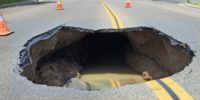What if we could crowdsource our Environmental, Health and Safety (EHS) data? This is a question I began asking myself after reading two articles published last year in the Wall Street Journal. Both articles focus on and detail the safety successes of the U.S. airline industry. Chief among these successes is that no commercial U.S. airline has experienced a fatal crash since 2009! This equates to "carrying more than eight billion without a fatal crash." For context, that is the equivalent of carrying the entire world's population via plane without a fatal crash! In addition, their safety strategy has been so effective that the healthcare industry, which currently experiences 250,000 unnecessary patient deaths a year in the U.S., is attempting to follow its protocols. So, what has helped the airline industry achieve such immense safety feats and how can EHS leaders in industries outside of the airline industry take a page out of their book?
An overview, airlines
In 1996, the airline industry in the U.S. had a fatal crash accident rate of one crash for every two million departures. That might seem solid; however, with roughly 5,000 flights a day, that equates to one fatal crash every 400 days. According to the former head of the FAA, Randy Babbitt, "we were seeing the same mistakes made over and over, but nobody talked about them" until it was too late."
In response to the dismal safety record catalyzed by high-profile crashes in the mid- 1990s, some senior regulators, top industry executives, and pilots-union leaders pushed for a safety re-boot. This re-boot would help to "combat common industry hazards." The team banded together to launch a voluntary incident reporting program with carriers sharing data and no punishment for airlines or aviators when mistakes were uncovered. The intended focus of this voluntary reporting program was to pinpoint accident precursors. The industry started by aggregating and analyzing near-crash reports, incident reports, and other hazard reports. Since then, the effort has expanded to include more advanced data such as flight path data, mechanics reports, and air-traffic controller reports. Currently, there are "ten separate voluntary reporting or data sharing programs covering everyone from airport workers to FAA engineers to technicians who maintain the agency's traffic control equipment."
Like any other initiative, it was not all butterflies and rainbows from the very beginning. As you can imagine, the initial voluntary reporting program idea was met with serious doubt and pushback. The original team had to "overcome deep-seated doubts from some insiders and outright opposition from pilots' groups worried about disciplinary blowback." In addition, intra-industry and regulatory trust was needed to make the voluntary reporting programs successful. The road is still bumpy and trust, understanding, and a good faith effort to identify and mitigate hazards is still paramount to the success of the voluntary reporting program. However, the rewards have been tremendous. The fatal crash rate in 1996 of 1 per 2 million departures has vastly improved to a fatal crash rate of 1 per 120 million departures!
Healthcare's adaptation
While still in the infant stages, the healthcare industry is looking to adopt the lessons from the airline industry with hopes of getting the same outstanding results. Catalyzed by a group in Pittsburgh, PA, the healthcare industry is attempting to institute a "National Patient Safety Board" that will aggregate and review hazard and incident reports similar to how the National Transportation Safety Board dissects incidents in the airline industry.
However, the healthcare industry is taking a slightly different approach than the airline industry. As detailed in the article, "the proposed NPSB wouldn't focus on investigating individual patient fatalities, the way the NTSB does with airline crashes. Instead, it would coordinate with the host of government organizations already tracking patient safety to pinpoint and counter budding dangers." The goal of the National Patient Safety Board is to "reveal the full extent of problems hidden by today's scattered safety statistics". This effort has not, and will not be without its roadblocks or detractors, but with proven results in the airline industry, the juice is worth the squeeze.
Crowdsourcing for all?
So why has this crowdsourcing idea not taken hold in other industries? As mentioned throughout this article, there are many skeptics, detractors, and roadblocks. Below, we will review the top three roadblocks and how to overcome them.
First off, we are potentially asking companies to hand over their missteps to government regulators voluntarily. For some, this alone might be enough to squash the idea of information sharing. However, as the airline industry has shown, with the right level of commitment from both parties and anonymity, a certain level of comfort can be reached to propel past this hurdle. For example, regulatory bodies have foregone or lessened enforcement for voluntarily reported incidents and hazards in the airline industry. There is a delicate balance required because total enforcement removal could breed complacency; however, incentivizing companies to report through the voluntary program is warranted. Furthermore, as more companies participate in the voluntary reporting program, the benefits potentially outweigh the costs because data collected for hazard mitigation will grow exponentially.
Second, the incentives need to change. The current safety key performance indicators (KPIs) and company incentives are typically focused on outcomes, not inputs. This is a similar issue that the healthcare industry experiences. In healthcare, financial incentives for hospitals "are still not aligned around quality and safety." Likewise, the focus on safety for manufacturing and construction companies varies widely. Overall, there is too much focus on the incident rates and outcomes and not enough focus on identification and prevention, i.e., the inputs. For a voluntary reporting program to succeed, there needs to be a shift in this incentive structure. The good news is that this shift in thinking is already underway! Go to any safety conference and listen to the general and keynote speakers. Everyone is talking about focusing on culture, leading indicators, and moving away from the old safety mindset/metrics. I believe a robust voluntary reporting program could help catalyze this transition.
Lastly, the technology in the airline industry is much more of a failsafe than other industries, and this delta in technology will lessen the effectiveness of the voluntary reporting program. As a healthcare executive remarked, "as long as hospital equipment isn't designed to guard against human slip-ups, as jetliner cockpits are, it will be far too easy to crash the plane in healthcare." This thinking is valid. For example, technology in the airline industry is so advanced; the next threat facing commercial airlines is the inability of pilots to fly planes manually as they have become so accustomed to autopilot! However, I believe this delta in technology is even more reason for a voluntary reporting program. Aggregating data across companies and industries can help us better understand how work conditions can affect human behavior not just in our facility but at scale.
Furthermore, it will allow insights into the work environment and work behavior errors that we haven't identified or experienced inside our companies or facilities. Voluntary reporting programs can grow every company's dataset without massive investments in automated intelligence or other automated data collection technologies. In the current state, many companies are adopting software to streamline reporting. This is great for three reasons. One, software tends to lower the barrier to data entry, so more data is collected from around the organization and aggregated. Two, this aggregation gets you one step closer to transferring data to a voluntary reporting program in a standardized and efficient way. Three, the insights collected from the reporting system can easily be imported and analyzed against your company data. Data collection processes can then be quickly adjusted based on learnings from voluntary reporting. Focusing on a voluntary reporting program assisted by technology goes a long way in creating a safe work environment.
Final Thoughts
According to the BLS, in 2020, the overall workplace fatality rate in construction was 10.2 per 100,000 full-time workers. During the same year, the overall workplace fatality rate for manufacturing was 2.3 per 100,000 full-time workers. Suppose each of these industries instituted a voluntary reporting program and experienced even a faction of the airline industry's success. We would save numerous lives every year with high probability. Yes, there are hurdles to jump in scaling a voluntary reporting program, no doubt. Still, if the airline industry is any indication, the pain would be worth the gain and help us take a giant leap towards ending death on the job.
If you are interested in hearing more about how we can work together to create a voluntary reporting program, don't hesitate to contact me at Angelo.Cianfrocco@intelex.com.
Referenced Articles:
https://www.wsj.com/articles/the-airline-safety-revolution-11618585543
https://www.wsj.com/articles/can-hospitals-learn-about-safety-from-airlines-11630598112




